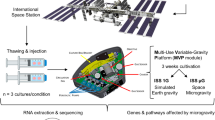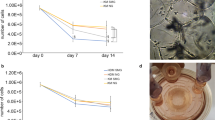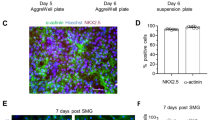Abstract
The PICM-19 pig liver stem cell line was cultured in space for nearly 16 d on the STS-126 mission to assess the effects of spaceflight on the liver’s parenchymal cells—PICM-19 cells to differentiate into either monolayers of fetal hepatocytes or 3-dimensional bile ductules (cholangiocytes). Semi-quantitative data included light microscopic assessments of final cell density, cell morphology, and response to glucagon stimulation and electron microscopic assessment of the cells’ ultrastructural features and cell-to-cell connections and physical relationships. Quantitative assessments included assays of hepatocyte detoxification functions, i.e., inducible P450 activities and urea production and quantitation of the mRNA levels of several liver-related genes. Three post-passage age groups were included: 4-d-, 10-d-, and 14-d-old cultures. In comparing flight vs. ground-control cultures 17 h after the space shuttle’s return to earth, no differences were found between the cultures with the exception being that some genes were differentially expressed. By light microscopy both young and older cultures, flight and ground, had grown and differentiated normally in the Opticell culture vessels. The PICM-19 cells had grown to approximately 75% confluency, had few signs of apoptosis or necrosis, and had either differentiated into monolayer patches of hepatocytes with biliary canaliculi visible between the cells or into 3-dimensional bile ductules with well-defined lumens. Ultrastructural features between flight and ground were similar with the PICM-19 cells displaying numerous mitochondria, Golgi apparatus, smooth and rough endoplasmic reticulum, vesicular bodies, and occasional lipid vacuoles. Cell-to-cell arrangements were typical in both flight and ground-control samples; biliary canaliculi were well-formed between the PICM-19 cells, and the cells were sandwiched between the STO feeder cells. PICM-19 cells displayed inducible P450 activities. They produced urea in a glutamine-free medium and produced more urea in response to ammonia. The experiment’s aim to gather preliminary data on the PICM-19 cell line’s suitability as an in vitro model for assessments of liver function in microgravity was demonstrated, and differences between flight and ground-control cultures were minor.







Similar content being viewed by others
References
Abraham S.; Klein H. P.; Lin C. Y.; Volkmann C. The effects of space flight on some rat liver enzymes regulating carbohydrate and lipid metabolism. Adv Space Res 1: 199–217; 1981.
Abraham S.; Lin C. Y.; Volkmann C. M.; Klein H. P. Biochemical changes in rat liver after 18.5 d of spaceflight. Proc Soc Exp Biol Med 172: 334–9; 1983.
Ahlers I.; Tigranyan R. A.; Praslicka M. The effect of artificial gravity on plasma and tissue lipids in rats: the Cosmos 936 experiment. Adv Space Res 1: 193–8; 1981.
Blomberg L. A.; Long E. L.; Sonstegard T. S.; Van Tassell C. P.; Dobrinsky J. R.; Zuelke K. A. Serial analysis of gene expression during elongation of the peri-implantation porcine trophectoderm (conceptus). Physiol Genomics 20: 188–94; 2005.
Brooks F. A.; Gardner R. L. The origin and efficient derivation of embryonic stem cells in the mouse. Proc Natl Acad Sci USA 94: 5709–5712; 1997.
Chang T. T.; Hughes-Fulford M. Monolayer and spheroid culture of human liver hepatocellular carcinoma cell line cells demonstrate distinct global gene expression patterns and functional phenotypes. Tissue Eng Part A 15: 559–67; 2009.
Clavin M.; Gazenko O. G. (eds). Foundations of space biology and medicine, NASA SP-374. National Aeronautics and Space Administration Scientific and Technical Information Office, Washington, DC; 1975.
Clément G. Fundamentals of space medicine. Springer, Dordrecht, The Netherlands; 2005.
Clement J. Q.; Lacy S. M.; Wilson B. L. Genome-wide gene expression profiling of microgravity effect on human liver cells. J Gravit Physiol 14: P121–2; 2007.
Denisova L. A.; Lavrova E. A.; Natochin Iu V; Serova L. V. Water and electrolyte content of the organs and tissues of male rats following a flight on the Kosmos 1667 biosatellite. Kosm Biol Aviakosm Med 22: 33–7; 1988.
Donato M. T.; Gomez-Lechon M. J.; Castell J. V. A microassay for measuring sytochrome P450IA1 and P450IIB1 activities in intact human and rat hepatocytes cultured on 96-well plates. Anal Biochem 213: 29–33; 1993.
Enzan H.; Ohkita T.; Fujuta H.; Iijima S. Light and electron microscopic studies on the development of periportal bile ducts of the human embryo. Acta Pathol Jpn 24: 427–447; 1974.
Freed L. E.; Vunjak-Novakovic G. Spaceflight bioreactor studies of cells and tissues. Adv Space Biol Med 8: 177–95; 2002.
Germain L.; Blouin M. J.; Marceau N. Biliary epithelial and hepatocytic cell lineage relationships in embryonic rat liver as determined by the differential expression of cytokeratins, alpha-fetoprotein, albumin, and cell surface-exposed components. Cancer Res 48: 4909–4918; 1988.
Gilloteaux J.; Karkare S.; Kelly T.; Hawkins W. S. Ultrastructural aspects of human gallbladder epithelial cells in cholelithiasis: production of anionic mucus. Microsc Res Tech 38: 643–659; 1997.
Guyton A. C.; Hall J. E. Textbook of medical physiology. 11th ed. Elsevier Saunders, Philadelphia; 2006.
Hatton J. P.; Gaubert F.; Cazenave J. P.; Schmitt D. Microgravity modifies protein kinase C isoform translocation in the human monocytic cell line U937 and human peripheral blood T-cells. J Cell Biochem 87: 39–50; 2002.
Hughes-Fulford M.; Lewis M. L. Effects of microgravity on osteoblast growth activation. Exp Cell Res 224: 103–9; 1996.
Husson A.; Buquet C.; Vaillant R. Induction of the five urea-cycle enzymes by glucagon in cultured foetal rat hepatocytes. Differentiation 35: 212–8; 1987.
Ikuzawa M.; Asashima M. Global expression of simulated microgravity-responsive genes in Xenopus liver cells. Zoolog Sci 25: 828–37; 2008.
Ishii M.; Vroman B.; LaRusso N. F. Isolation and morphologic characterization of bile duct epithelial cells from normal rat liver. Gastroenterology 97: 1236–1247; 1989.
Kacena M. A.; Todd P.; Landis W. J. Osteoblasts subjected to spaceflight and simulated space shuttle launch conditions. In Vitro Cell Dev Biol Anim 39: 454–9; 2003.
Khaoustov V. I.; Darlington G. J.; Soriano H. E.; Krishnan B.; Risin D.; Pellis N. R.; Yoffe B. Induction of three-dimensional assembly of human liver cells by simulated microgravity. In Vitro Cell Dev Biol Anim 35: 501–9; 1999.
Khaoustov V. I.; Risin D.; Pellis N. R.; Yoffe B. Microarray analysis of genes differentially expressed in HepG2 cells cultured in simulated microgravity: preliminary report. In Vitro Cell Dev Biol Anim 37: 84–8; 2001.
Komolova G. S.; Zakaznov A. V.; Makeeva V. F. Effect of weightlessness on the DNA replicative function of rat hepatocytes. Kosm Biol Aviakosm Med 21: 31–4; 1987.
Macchiarelli G.; Motta P. M. Ultrastructure of the hepatocyte. In: Tavoloni N.; Berk P. D. (eds) Hepatic transport and bile secretion: physiology and pathophysiology. Raven Press, New York, pp 103–116; 1993.
Macho L.; Fickova M.; Nemeth S.; Svabova E.; Serova L.; Popova I. The effect of space flight on the board of the satellite Cosmos 2044 on plasma hormone levels and liver enzyme activities of rats. Acta Astronaut 24: 329–32; 1991a.
Macho L.; Ficková M.; Zórad S.; Serova L.; Popova I. Plasma insulin levels and insulin receptors in liver and adipose tissue of rats after space flight. Physiologist 34(1 Suppl): S90–1; 1991b.
Macho L.; Nemeth S.; Kvetnansky R.; Fickova M.; Tigranian R. A.; Serova L. Metabolic changes in the animals subjected to space flight. Acta Astronaut 9: 385–9; 1982.
Merrill Jr. A. H.; Hoel M.; Wang E.; Mullins R. E.; Hargrove J. L.; Jones D. P.; Popova I. A. Altered carbohydrate, lipid, and xenobiotic metabolism by liver from rats flown on Cosmos 1887. FASEB J 1: 95–100; 1990.
Merrill Jr. A. H.; Wang E.; Jones D. P.; Hargrove J. L. Hepatic function in rats after spaceflight: effects on lipids, glycogen, and enzymes. Am J Physiol 252(2 Pt 2): R222–6; 1987.
Metoki K.; Hommes F. A. A possible rate limiting factor in urea synthesis by isolated hepatocytes: the transport of ornithine into hepatocytes and mitochondria. Int J Biochem 16: 1155–7; 1984.
Misurova E.; Tigranyan R. A.; Praslicka M. Changes of deoxyribonucleoprotein in the spleen, thymus and liver of rats exposed to weightlessness and artificial gravity aboard the Cosmos biosatellites. Adv Space Res 1: 225–30; 1981.
Miyake M.; Yamasaki M.; Katahira K.; Waki H.; Katsuda S.; Ijiri K.; Shimizu T. Effects of the spaceflight on organ-development in the neonatal rats: results in the Neurolab (STS-90). Biol Sci Space 16: 209–10; 2002.
Morrison D. R.; Chapes S. K.; Guikema J. A.; Spooner B. S.; Lewis M. L. Experiments with suspended cells on the Space Shuttle. Physiologist 35(1 Suppl): S31–4; 1992.
Nemeth S.; Macho L.; Palkovic M.; Skottova N.; Tigranyan R. A. Metabolic changes in rats subjected to space flight for 18.5 d in the biosatellite Cosmos 936. Adv Space Res 1: 219–24; 1981.
Nemeth S.; Tigranian R. A. Activity of various liver enzymes in rats following a flight aboard the Cosmos-936 biosatellite. Kosm Biol Aviakosm Med. 16: 77–80; 1982.
Popova I. A.; Zabolotskaia I. V.; Kurkina L. M. The effects of space flights on the lipid composition of blood, adrenal glands and liver in rats. Aviakosm Ekolog Med 33: 47–51; 1999.
Rabot S.; Szylit O.; Nugon-Baudon L.; Meslin J. C.; Vaissade P.; Popot F.; Viso M. Variations in digestive physiology of rats after short duration flights aboard the US space shuttle. Dig Dis Sci 45: 1687–95; 2000.
Racine R. N.; Cormier S. M. Effect of spaceflight on rat hepatocytes: a morphometric study. J Appl Physiol 73(2 Suppl): 136S–141S; 1992.
Rodríguez-Antona C.; Donato M. T.; Boobis A.; Edwards R. J.; Watts P. S.; Castell J. V.; Gómez-Lechón M. J. Cytochrome P450 expression in human hepatocytes and hepatoma cell lines: molecular mechanisms that determine lower expression in cultured cells. Xenobiotica 32: 505–20; 2002.
Sen S.; Williams R. New liver support devices in acute liver failure: a critical evaluation. Semin Liver Dis 23(3): 283–294; 2003.
Singh A.; Shahidi E. Ultrastructure of piglet liver. In: Tumbleson M. E. (ed) Swine in biomedical research, Vol. 1. Plenum Press, New York, p 84; 1987.
Strain A. J.; Neuberger J. M. A bioartificial liver—state of the art. Science 295: 1005–1009; 2002.
Sussman N. L.; Kelly J. H. The artifical liver. Sci Am 2: 68–77; 1995.
Talbot N. C.; Caperna T. J. Selective and organotypic culture of intrahepatic bile duct cells from adult pig liver. In Vitro Cell Dev Biol 34A: 785–798; 1998.
Talbot N. C.; Paape M. J. Continuous culture of pig tissue-derived macrophages. Meth Cell Sci 18: 315–327; 1996.
Talbot N. C.; Caperna T. J.; Lebow L. T.; Moscioni D.; Pursel V. G.; Rexroad Jr. C. E. Ultrastructure, enzymatic, and transport properties of the PICM-19 bipotent liver cell line. Exp Cell Res 225: 22–34; 1996.
Talbot N. C.; Caperna T. J.; Wells K. D. The PICM-19 cell line as an in vitro model of liver bile ductules: effects of cAMP inducers, biopeptides and pH. Cells Tissues Organs 171: 99–116; 2002.
Talbot N. C.; Powell A.; Garrett W.; Edwards J. L.; Rexroad Jr. C. E. Ultrastructural and karyotypic examination of in vitro produced bovine embryos developed in the sheep uterus. Tissue Cell 32: 9–27; 2000.
Talbot N. C.; Pursel V. G.; Rexroad Jr. C. E.; Caperna T. J.; Powell A. M.; Stone R. T. Colony isolation and secondary culture of fetal porcine hepatocytes on STO feeder cells. In Vitro Cell Dev Biol 30A: 851–858; 1994a.
Talbot N. C.; Rexroad Jr. C. E.; Powell A.; Pursel V. G.; Caperna T. J.; Ogg S. L.; Nel N. D. A continuous culture of pluripotent fetal hepatocytes derived from the 8-day epiblast of the pig. In Vitro Cell Dev Biol 30A: 843–850; 1994b.
Talbot N. C.; Jr C. E.; Rexroad V. G. Pursel; Powell A. M.; Nel N. D. Culturing the epiblast cells of the pig blastocyst. In Vitro Cell Dev Biol 29A: 543–554; 1993.
Tanaka M. A histochemical study on the activity of gamma-glytamyl transpeptidase in liver disease. Acta Path Jpn 24: 651–665; 1974.
Tietze K. J.; Putcha L. Factors affecting drug bioavailability in space. J Clin Pharmacol 34: 671–6; 1994.
Triebwasser K. C.; Freedland R. A. The effect of glucagon on ureagenesis from ammonia by isolated rat hepatocytes. Biochem Biophys Res Commun 76: 1159–65; 1977.
Unsworth B. R.; Lelkes P. I. Growing tissues in microgravity. Nat Med 4: 901–7; 1998.
Wanson J. C.; Drochmans P.; Mosselmans R.; Ronveaux M. F. Adult rat hepatocytes in primary monolayer culture: ultra-structural characteristics of intercellular contacts and cell membrane differentiations. J Cell Biol 74: 858–877; 1977.
Wybenga D. R.; Di Giorgio J.; Pileggi V. J. Manual and automated methods for urea nitrogen measurement in whole serum. Clin Chem 17: 891–5; 1971.
Yamashita M.; Izumi-Kurotani A.; Imamizo M.; Koike H.; Okuno M.; Pfeiffer C. J.; Komazaki S.; Sasaki F.; Ohira Y.; Kashima I.; Kikuyama S.; Ohnishi T.; Mogami Y.; Asashima M. Japanese red-bellied newts in space—AstroNewt experiment on space shuttle IML-2 and space flyer unit. Biol Sci Space 15: 96–s103; 2001.
Acknowledgments
We thank Drs. Wesley Garrett and Julie Long for reading the manuscript and offering helpful editorial and scientific comments in its final preparation. We thank Amy Shannon, Ryan Willard, and John Meekin for their assistance in the laboratory and Ms. Jennifer Devich at KSC for logistical assistance. We thank the staff members of BioServe Space Technologies, University of Colorado, Boulder, CO, for their attention to detail and expertise in guiding the project to a successful conclusion, and especially thank Ms. Stefanie Countryman for her assistance, in general, and most especially for retrieving the samples from Edwards Air Force Base, CA. We also thank Scott McFarland of Boeing Aerospace and John Wayne Kennedy for guidance, meeting support, and encouragement in the project.
This work was supported by NASA, BioServe Space Technologies, Inc., Zero Gravity, Inc., Hepalife Technologies, Inc., and the State of Maryland (TEDCO). Mention of trade names or commercial products in this publication is solely for the purpose of providing specific information and does not imply recommendation or endorsement by the US Department of Agriculture.
Author information
Authors and Affiliations
Corresponding author
Additional information
Editor: J. Denry Sato
Rights and permissions
About this article
Cite this article
Talbot, N.C., Caperna, T.J., Blomberg, L. et al. The effects of space flight and microgravity on the growth and differentiation of PICM-19 pig liver stem cells. In Vitro Cell.Dev.Biol.-Animal 46, 502–515 (2010). https://doi.org/10.1007/s11626-010-9302-6
Received:
Accepted:
Published:
Issue Date:
DOI: https://doi.org/10.1007/s11626-010-9302-6




